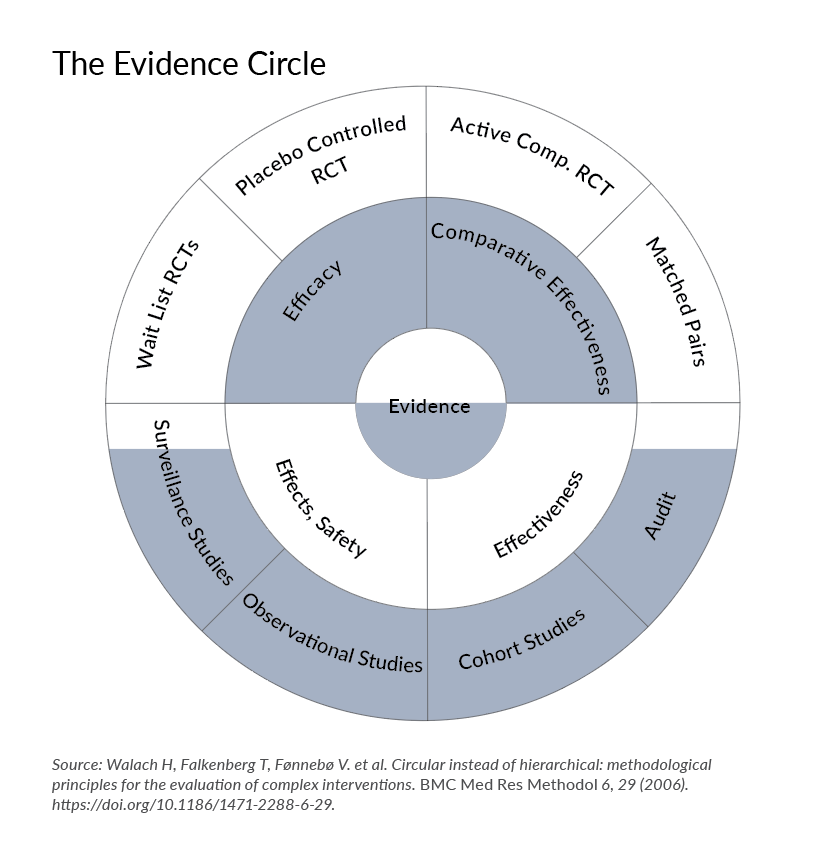Continuing Education
Reading A Research Article
Learn to read, evaluate and critique research, and to adapt these skills to write your own article.
Understanding levels of evidence and the evidence circle.
Martha Brown Menard, PhD, LMT, November 1, 2020

Understanding research is important for several reasons. Research supports the theoretical foundation of any discipline and helps separate treatments that are effective from those that are not. As health care providers, massage therapists need to be able to critically evaluate existing research to make better decisions about the care we give to our clients. For example, should we learn a particular massage technique and change the way we currently practice based on a recent research study?
By understanding relevant research, we may choose to introduce new ways of working with clients, or discard methods that don’t appear to offer any benefit. How do we decide? Understanding levels of evidence is a useful tool to evaluate the quality of evidence presented in a journal article and make informed decisions.
In many kinds of health care research, we want to know whether a certain treatment (cause) is responsible for a particular outcome (effect). For example, does massage help premature babies gain weight? What factors (cause) contribute to developing an illness or promoting health (effect)? In critically evaluating a journal article, we are assessing the evidence that the authors/researchers have presented. How well have they argued their case that this treatment or factor is responsi- ble for or associated with that result?
In any research article, the authors are presenting their findings and offering their interpretation of what those findings mean. In other words, the author is making a case for the reader to decide to what extent they accept, accept with reservations or reject the evidence presented, based on how strongly the authors have linked cause with effect. It’s rare that a single study demonstrates a hypothesis so conclusively that it is beyond question. The more common scenario is that a body of evidence accumulates, study by study, with various studies contributing different degrees or kinds of evidence.
Following is a summary of the different types of research studies or designs.
Within the research community, there has traditionally been a hierarchy of weight based on the strength of the association between cause and effect that particular designs incorporate. The relative strength of each design is thought of schematically as a pyramid shape, with stud- ies that provide weaker degrees of evidence at the bottom and the strongest designs at the top.
Early literature on effects of massage were largely based on Level 5, mechanism-based reasoning, and over the last 30 years, a number of controlled studies have validated many of these. Case reports are usually considered Level 4, and can include the before-and-after treatment design, with the “before” considered a historical control. These types of studies can be used to note associations between events and to generate testable hypotheses.
Level 3 includes the cohort study and nonrandomized controlled trial, which do not employ random assignment to a group. In Level 2 studies, the inclusion of random assignment, where some participants receive a treatment, are then compared to others who receive a different intervention (or no intervention). These types of experimental studies provide a stronger link between cause and effect; in these, the investi- gator is systematically testing hypotheses that a specific intervention has a specific result. This model works well for pharmaceutical studies, but is less well-suited to complex interventions like massage therapy.
Meta-analyses and systematic reviews (Level 1) are evaluations of groups of studies on a specific research question. By combining studies and then assessing them as a group, the authors can evaluate the weight of the evidence as a whole on that question. However, the studies included in these type of reviews must be similar enough in their design and outcome measures, such that it makes sense to combine them in a meaningful way. All too many of these conclude that there are simply not enough high-quality studies to evaluate, and that they cannot reach a conclusion—not enough evidence. Too often, lack of evidence is confused with lack of benefit.
One alternative to the evidence hierarchy or pyramid, especially for complex interventions like massage, is what Harald Walach refers to as the evidence circle.

In this model, different types of studies are viewed as complementary to each other rather than stronger or weaker, only on the basis of linking cause and effect. In this model, well-designed, descriptive, qualitative studies have value and can provide insight into a randomized controlled trial. This multiplicity of approaches, using different study designs to counterbalance the strengths and weaknesses of individual studies, is a rigorous yet practical and more nuanced way to assess the benefit of therapies like massage, while still promoting evidence-based health care.
1. Walach H, Falkenberg T, Fønnebø V, Lewith G, Jonas WB. "Circular instead of hierarchical:methodological principles for the evaluation of complex interventions." BMC Med Res Methodol. 2006. Jun 24;6:29.